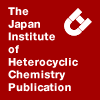

HETEROCYCLES
An International Journal for Reviews and Communications in Heterocyclic ChemistryWeb Edition ISSN: 1881-0942
Published online by The Japan Institute of Heterocyclic Chemistry
Regular Issue
Vol. 68, No. 12, 2006
Published online: 27th October, 2006
■ Synthesis of Octahydropyrrolo[3,2-c]pyridine Derivatives by the Catalytic Asymmetric Intramolecular Cycloaddition of Azomethine Ylides
Yoji Oderaotoshi,* Hiroyuki Miyata, Satoshi Minakata, and Mitsuo Komatsu*
*Department of Applied Chemistry, Graduate School of Engineering, Osaka University, 2-1 Yamadaoka, Suita, Osaka 560-0871, Japan
Abstract
The synthesis of optically active octahydropyrrolo[3,2-c]pyridine derivatives was achieved via the asymmetric intramolecular cycloaddition of azomethine ylides using copper-bisphosphine complexes. Cu(OTf)2-(R,R)-CHIRAPHOS is a suitable catalyst for the reactions.
Published online: 2nd November, 2006
■ Synthesis of Chiral Non Racemic Indolizidin-3-ones as Peptidomimetic Scaffold
Delphine Halie, Joëlle Pérard-Viret, and Jacques Royer*
*Faculty of Pharmacy, UMR 8638 (CNRS-University Paris 5), 4 Avenue de l’Observatoire, 75270 Paris Cedex 06, France
Abstract
A new asymmetric strategy has been devised to attain indolizidin-3-ones wich can be used as peptidomimetic scaffolds. The sequence is a two-step synthesis.
Published online: 2nd November, 2006
■ Sugar Binding to an Calix[4]arene-Based Receptor
Takeharu Haino,* Masaki Nakamura, and Yoshimasa Fukazawa*
*Department of Chemistry, Graduate School of Science, Hiroshima University, 1-3-1 Kagamiyama, Higashi-hiroshima, Hiroshima 739-8526, Japan
Abstract
The binding properties of the calix[4]arene-based artificial receptor (1) toward carboxylate-containing sugars in DMSO are demonstrated. The receptor shows the 1:1 host-guest complexation with the sugars. The hydrogen bonds forming to the hydroxyl groups play a crucial role for the guest selection.
Published online: 24th October, 2006
■ Synthetic Utilization of Polynitro Aromatic Compounds. 5. Multi-Centered Reactivity Pattern in Reactions of 4,6-Dinitro-1,2-benzisothiazoles and -isothiazol-3(2H)-ones with C-, N-, O-, S-, and F-Nucleophiles
Sergei G. Zlotin,* Pavel G. Kislitsin, Fedor A. Kucherov, Evgeny A. Serebryakov, Yury A. Strelenko, and Andrei A. Gakh*
*Oak Ridge Naitonal Laboratory, 1 Bethel Valley Rd., Oak Ridge, TN 37831-6242, U.S.A.
Abstract
Reactions of 4,6-dinitro-1,2-benzisothiazoles, -isothiazol-3(2H)-ones, and -isothiazol-3(2H)-one-1-oxides with C-, N-, O-, S-, and F-nucleophiles give products of aromatic nucleophilic substitution of one or two nitro groups, “vicarious” substitution of the hydrogen atom H-7, or heterocyclic S-N bond cleavage depending on the structure of the starting compound and the nature of the nucleophile. These reactions provide a new synthetic approach to a family of biologically active benzisothiazol-3(2H)-ones based on 2,4,6-trinitrotoluene (TNT).
Published online: 24th October, 2006
■ Crystal Structure of Triphenyl Cyamelurate (2,5,8-Triphenoxy-1,3,4,6,7,9,9b-heptaazaphenalene)
Marcus R. Schwarz, Helmut Ehrenberg, Matthäus A. Kloc, and Edwin Kroke*
*Institute for Inorganic Chemistry, TU-Bergakademie Freiberg, Leipziger Strasse 29, D-09596, Germany
Abstract
2,5,8-Triphenoxy-1,3,4,6,7,9,9b-heptaazaphenalene (triphenyl cyamelurate, C6N7(OPh)3) was synthesized under solvent free conditions from cyameluric chloride (C6N7Cl3) and phenol via nucleophilic substitution. Needle-shaped crystals were obtained via a vapor transport method. Single crystal XRD revealed that C6N7(OPh)3 crystallizes in the monoclinic space group P 21/c with the lattice parameters a = 14.463(17) Å, b = 4.697(3) Å, c = 31.60(4) Å and β = 99.76(9)°. All three phenyl rings are rotated and inclined differently with respect to the central heptazine units, which themselves form inclined stacks along the b axis. Intermolecular cohesion is provided via dipolar, aromatic and van-der-Waals interactions as well as some weak C-H···N and C-H···O hydrogen bridges.
Published online: 31st October, 2006
■ Total Inversion of Cis-C5 Maxacalcitol into Its Trans-C5 Isomer via the Sulforene Intermediate
Tsuyoshi Yamauchi,* Koji Suzuki, Hitoshi Shimizu, and Masahiro Kato
*Pre-Clinical Research Department I, Fuji-gotemba Research Laboratories, Chugai Pharmaceutical Company, Ltd., 135, 1-Chome Komakado, Gotemba City, Shizuoka 412-8513, Japan
Abstract
Total inversion of the cis-C5 configuration of Maxacalcitol, the unnatural 22-oxa-vitamin D3 analogue used for the treatment of secondary hyperparathyroidism and psoriasis, into the trans-C5 isomer has been accomplished stereoselectively via a formation of the sulforene intermediate for biological evaluation.
Published online: 24th October, 2006
■ Recyclization of 7-Fluoroalkyl-4,7-dihydroazolo[5,1-c]triazines into 5-(Pyrazolinylhydrazono)azoles in the Reactions with Hydrazides and Thiosemicarbazide
Olga G. Khudina, Evgeny V. Shchegol’kov, Yanina V. Burgart, Mikhail I. Kodess, Victor I. Saloutin,* and Oleg N. Chupakhin
*Institute of Organic Synthesis, Urals Branch, Russian Academy of Sciences, 20, S. Kovalevskaya st., Ekaterinburg, GSP-147, 620219, Russia
Abstract
7-Fluoroalkyl-4,7-dihydroazolo[5,1-c][1,2,4]triazines react with hydrazides and thiosemicarbazide to form 5-(5-hydroxy-5-polyfluoroalkyl-2-pyrazoline-4-ylhydrazono)azoles as a result of triazine ring opening at bond C-7-N-8 and followed by regio-selective condensation.
Published online: 27th October, 2006
■ Hydantoins and Thiohydantoins Derived from 1,2,3,4-Tetrahydroisoquinoline-3-carboxylic Acid
Petr Jansa, Vladimír Wsól, Valerio Bertolasi, and Vladimír Machácek*
*Department of Organic Chemistry, Faculty of Chemical Technology, University of Pardubice, 53210 Pardubice, Czech Republic
Abstract
The reaction of methyl (S)-1,2,3,4-tetrahydroisoquinoline-3-carboxylate with isocyanates (phenyl, naphthalen-1-yl, cyclohexyl, (S)-1-methylbenzyl) in ether has been used to prepare N-substituted methyl (3S)-2-aminocarbonyl-1,2,3,4-tetrahydroisoquinoline-3-carboxylates. These compounds were cyclised by action of CF3COOH to give the corresponding 2-substituted (10aS)-10,10a-dihydroimidazo[1,5-b]isoquinoline-1,3(2H,5H)-diones (hydantoins Tic-H). Hydantoins Tic-H were also prepared by the reaction of methyl (S)-1,2,3,4-tetrahydroisoquinoline-3-carboxylate with isocyanates (methyl, (1S)-1-methylbenzyl, 4-methylphenyl, 3-methylphenyl, 4-chlorophenyl, 2,4-dichlorophenyl, 4-methoxyphenyl, 5-chloro-2-methoxyphenyl, 3-chloro-4-ethoxyphenyl) and triethylamine in CH2Cl2. 2-Substituted (10aS)-3-thioxo-1,2,3,5,10,10a-hexahydroimidazo[1,5-b]isoquinolin-1-ones (thiohydantoins Tic-TH) were prepared analogously by the reaction of methyl (S)-1,2,3,4-tetrahydroisoquinoline-3-carboxylate with isothiocyanates (methyl, ethyl, allyl, phenyl). The optical purity of selected substances was determined chromatographically.
Published online: 31st October, 2006
■ Thermolysis of 5-Azido-4-arylpyridazin-3(2H)-ones: An Efficient and Versatile Synthesis of Pyridazino[4,5-b]indoles
Norbert Haider* and Andrea Wobus
*Department of Drug Synthesis, Faculty of Life Sciences, University of Vienna, Althanstrasse 14, A-1090 Vienna, Austria
Abstract
5-Azido-4-arylpyridazin-3(2H)-ones, which are easily available from 4,5-dihalopyridazin-3(2H)-ones in few steps, were found to undergo in high yields a thermally induced cyclization into pyridazino[4,5-b]indole derivatives (“aza-carbolinones”) by formation of the N-5/C-5a bond via a nitrene insertion process. This new method is complementary to a previously reported pathway in which the C-4a/N-5 bond of the ring system is formed.
Published online: 27th October, 2006
■ Electrooxidative Cyclization of Hydroquinolyl Alcohols
Mitsuhiro Okimoto,* Takashi Yoshida, Masayuki Hoshi, Kazuyuki Hattori, Masashi Komata, Kaori Numata, and Kenta Tomozawa
*Department of Applied and Environmental Chemistry, Kitami Institute of Technology, Koen-cho 165, Kitami, Hokkaido 090-8507, Japan
Abstract
Several hydroquinolyl, hydroisoquinolyl, and indolinyl alcohols were electrochemically oxidized in methanol in the presence of sodium methoxide and potassium iodide. The hydroquinolyl and hydroisoquinolyl alcohols afforded the corresponding intramolecular cyclization products through the bond formation between the α-carbon of the nitrogen atom and the oxygen atom of the hydroxy group. In contrast, the indolinyl alcohols underwent dehydrogenation to give the corresponding indolyl alcohols. Presumably, in all cases, the electrooxidation involves a two-electron oxidation process.
Published online: 2nd November, 2006
■ Synthesis of Chiral 1,2-Dihydropyridines and 2,3,4-Trisubstituted Pyridines from α-Amino Acids
Daiki Monguchi, Swapan Majumdar, and Takeo Kawabata*
*Institute for Chemical Research, Kyoto University, Uji, Kyoto 611-0011, Japan
Abstract
Chiral 1,2-dihydropyridines were prepared by Dieckmann condensation of α-amino acid derivatives. The dihydropyridines were converted to 2,3,4-trisubstituted pyridines.
Published online: 27th October, 2006
■ First Synthesis of Trans- and Cis-Dendrochrysanines
Hiroyuki Konno,* Sayako Kusumoto, Sotaro Kanai, Yasuyuki Yamahana, Kazuto Nosaka, and Kenichi Akaji
*Department of Chemistry, Graduate School of Medical Science, Kyoto Prefectural University of Medicine, Kita-ku, Kyoto 603-8334, Japan
Abstract
Trans- and cis-dendrochrysanines (1 and 2), isolated from the stems of Dendrobium chrysanthum Wall., were first synthesized from L-proline. The absolute configuration of 1 and 2 was established to be S by the syntheses.
Published online: 17th October, 2006
■ Total Synthesis of (±)-2-epi-Validamine
Hiroaki Okamura,* Hiroshi Nagaike, Nsiama Tienabe Kipassa, Tetsuo Iwagawa, and Munehiro Nakatani
*Department of Chemistry and Bioscience, Faculty of Science, Kagoshima University, 1-21-35 Korimoto, Kagoshima 890-0065, Japan
Abstract
(±)-Validamine and its epimers, (±)-2-epi-validamine (DL-5a-carba-α-mannopyranosylamine) and (±)-2-epi-3-epi-validamine (DL-5a-carba-α-altropyranosylamine) were synthesized from a poly-functionalized bicyclolactam that obtained by a base-catalyzed Diels-Alder reaction of N-tosyl-3-hydroxy-2-pyridone and methyl acrylate. All isomers were prepared via a common key intermediate in six or seven steps.
Published online: 31st October, 2006
■ Reduction of Nitroindazoles: Preparation of New Amino and Chloroamino Derivatives
Abdellah Miloudi, Douniazed El Abed, Gerard Boyer,* and Jean-Pierre Galy
*UMR Symbio 6178, case 552, University Paul Cezanne, Avenue Escardrille Normandie-Niemen, 13397 Marseille Cedex 20, France
Abstract
The synthesis of chloroaminoindazoles by the reduction of the nitro group of indazoles using stannous chloride in alcoholic acid solution is reported. Using catalytic hydrogenation with palladium the expected reduction to amino-indazoles occur.
Published online: 24th October, 2006
■ Exclusive Formation of α-Anomers in NbCl5-Promoted Ferrier Rearrangement for the Synthesis of 2,3-Unsaturated Glycosides
Ronaldo N. de Oliveira, Adriana C. N. de Melo, Rajendra M. Srivastava,* and Denis Sinou
*Departamento de Química Fundamental, Universidade Federal de Pernambuco, Cidade Universitária, 50740-540, Recife, PE, Brazil
Abstract
NbCl5-catalyzed reaction of primary and secondary alcohols with tri-O-acetyl-D-glucal is described. Exclusive formation of α-anomers of eight 2,3-unsaturated glycosides (3a-h) in high yields has been observed. Among eight unsaturated glycosides (3a-h) prepared, two of them (3d,e) are new. A new mechanism of the formation of (3a-h) from tri-O-acetyl-D-glucal and an alcohol assisted by NbCl5 as a catalyst has been suggested.
Published online: 24th October, 2006
■ Studies on Pyrazine Derivatives. XLIX. Synthesis and Antibacterial Activity of 6-Methoxypyrazine-2-carboxylic Acid Hydrazide Derivatives
Katarzyna Gobis,* Henryk Foks, Aleksandra Zuralska, and Anna Kedzia
*Department of Organic Chemistry, Medical University of Gdansk, Al. Gen. Hallera 107, 80-416 Gdansk, Poland
Abstract
The new 6-methoxy-pyrazine derivatives have been synthesized. 6-Methoxy-pyrazine-2-carboxylic acid hydrazide was used as an initial material to obtain mono- and dithioester of hydrazinecarbodithioic acid (2 and 3). Compound (2) in reaction with ethanolamine gave triazole derivative (8) with β-hydoxyethyl substituent in 4-position and hydroxyl group in 6-position of pyrazine ring. Dithioester (3) in a reaction with morpholine cyclized to 1,3,4-oxadiazole (11). The same substrate with alkyldiamines gave the few following derivatives: 1,3-diazacycloalkane derivatives (9 and 10), S-methyl-1,3,4-oxadiazole derivative (12) and 1,2,4-triazoletetrahydropyrimidine (13). The compounds obtained were tested in vitro for their activity towards pathogenic strains of anaerobic and aerobic bacteria. Derivative (9) was the most active against both types of tested strains.
Published online: 27th October, 2006
■ Synthesis of 2-Amino-4,5-dihydro-1,3-selenazol-4-ones by Reaction of N,N-Disubstituted Selenoureas with Acetylenedicarboxylate
Mamoru Koketsu,* Koichi Kanoh, and Hideharu Ishihara*
*Division of Instrumental Analysis, Life Science Research Center, Gifu University, 1-1 Yanagito, Gifu, Gifu 501-1193, Japan
Abstract
Reaction of N,N-disubstituted selenoureas with dimethyl acetylenedicarboxylate afforded 2-amino-5-methoxycarbonylmethylene-4,5-dihydro-1,3-selenazol-4-ones in high yields. The crystal structure of 5-methoxycarbonylmethylene-2-piperidino-4,5-dihydro-1,3-selenazol-4-one was confirmed by X-Ray diffraction. Reaction of the N,N-disubstituted selenoureas with acetylenedicarboxylic acid gave 2-amino-5-carboxymethylene-4,5-dihydro-1,3-selenazol-4-ones in high yields.
Published online: 2nd November, 2006
■ Efficient New Approach for the Synthesis of N,N-Dialkylamino-1,2,4-triazoles
Qiang Zhang,* Youyi Peng, and William J. Welsh*
*Department of Pharmacology and the Informartics, University of Medicine and Dentistry of New Jersey, 661 Hoes Lane, Piscataway, New Jersey 00854, U.S.A.
Abstract
A series of 3-N,N-dialkylamino-4,5-diaryl-1,2,4-triazoles were synthesized in high yield under mild reaction conditions by coupling functionalized arylmagnesiums with isothiocyanates and cyclization with Viehe’s salts. No selective thionation reaction was required for the preparation of carbamoyl derivatives.
Published online: 27th October, 2006
■ Synthesis of 2-Amino-1,3-selenazoles by Reaction of N,N-Unsubstituted Selenoureas with α,β-Unsaturated Aldehydes
Mamoru Koketsu,* Koichi Kanoh, and Hideharu Ishihara*
*Division of Instrumental Analysis, Life Science Research Center, Gifu University, 1-1 Yanagito, Gifu, Gifu 501-1193, Japan
Abstract
2-Dialkylamino-1,3-selenazoles were obtained by the reaction of N,N-unsubstituted selenoureas with α,β-unsaturated aldehydes in alcohol in the presence of ferric chloride at room temperature.
Published online: 27th October, 2006
■ Synthesis and Characterization of a Series of Alkyloxadiazolylpyridinium Salts as Perspective Ionic Liquids
Ivana Pibiri, Andrea Pace,* Antonio Palumbo Piccionello, Paola Pierro, and Silvestre Buscemi*
*Dipartimento di Chimica Organica, Università digli Studi di Palermo, Viale delle Scienze, Parco d’Orleans II, 90128 Palermo, Italy
Abstract
The synthesis of a series of 1,2,4-oxadiazolyl-N-methylpyridinium salts differing in the length and the position of the alkyl chain in the heterocyclic ring and the counter ions is reported. Some features of this new family of salts as perspective ionic liquids are described and the influence of the varying moieties in the modulation of the properties is discussed.